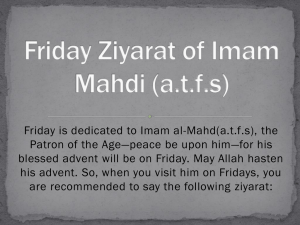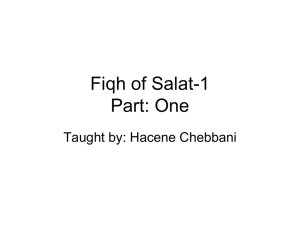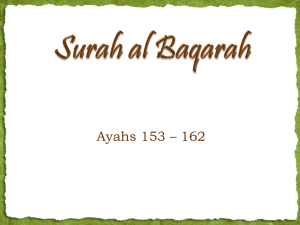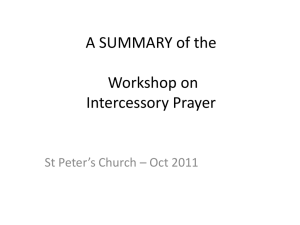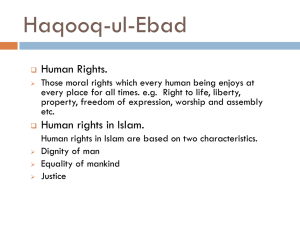Fiqh of Salat
advertisement
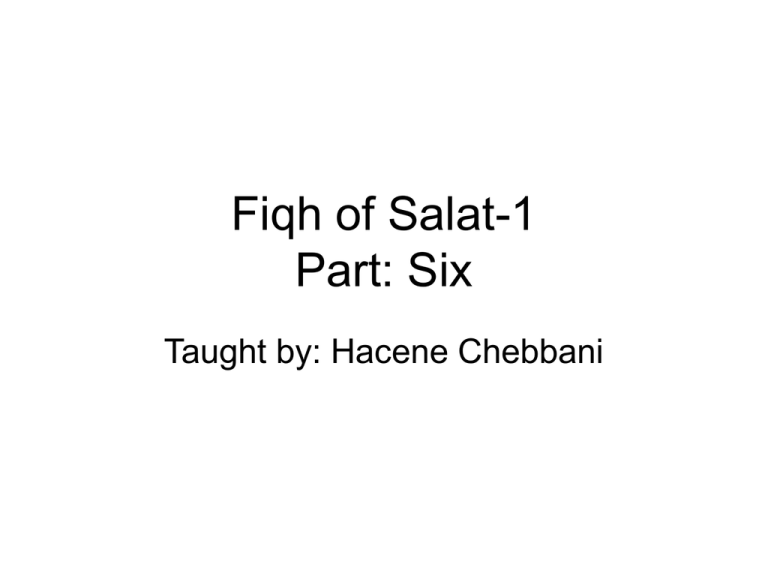
Fiqh of Salat-1 Part: Six Taught by: Hacene Chebbani Sunan of Salat • A sunnah in the prayer is any statement or action that is not a pillar or wajib. • If missed by purpose, than no sujud sahew (forgetfulness) is required. If he was intending to do it, but he forgot it, then he should perform this sujud at the end. Allah knows best. • What are the sunan of Salat? Sunan of Salat 1. Raising the Hands: This should be done upon making the opening takbir, when making ruku’, when straightening up from it and upon standing up from the first tashahhud. That was the sunnah of Allah’s Messenger (pbuh). 2. How about raising the hands before making sujood or while raising the head from the position of sujood? Two opinions. Raising the Hands • Abdullah bin Omar ® said: “Allah’s Messenger used to raise his hands up to his shoulders when he began the prayer, when he made takbir prior to ruku’ and when he stood up from ruku’ he would likewise raise them” (B/M) • Nafa’e related that when Ibn Umar stood for the third rakah, he would raise his hands, an action which he ascribed to the Prophet. (B/others) Raising the Hands • How Should we Raise the Hands?: There are two ways of raising the hands: • First One: Raising the hands to the shoulders. Hadith: “Allah’s Messenger used to raise his hands up to his shoulders…” • Second one: Raising the hands up to the lobes of his ears. Hadith: “I saw the prophet (pbuh) raising his hands up to the lobes of his ears in prayer, …” narated by Malik ibn al-Huwayrith. Raising the Hands • It is preferred that one extends the fingers while raising the hands. Abu Huraira ® said: “When the prophet (pbuh) stood for prayer, he would raise his hands (with them being) open.” (Ahmed/others) • The fingers are supposed to be collected (not separated). • One should raise the hands at about the same time he makes the takbir, but if he raises them after or before takbir, that should be fine. • Women need to do this raising the same way men do it. Sunan of Salat-Cont 2. Placing the Right hand on the Left over the Chest: Sahl bin Sa’d said: “People used to be commanded that a man should place his right hand on his left arm in prayer.” Abu Haazim said: “I do not know this except that he referred this sunnah to Allah’s Messenger (pbuh)” (B/others) Waa’il ibn Hijr ® said: “I prayed with the Messenger of Allah (pbuh) and he placed his right hand upon his left on his chest.” (Ibn Khuzaimah) The Position of the Hands • In a different version he said: “Then he put his right hand over the back of his left palm with the wrist and the forearm.” (Abu Dawood/Nasai’) • Note: This placing could be done in two ways: – The right hand holding the left one over the chest. – Placing the right hand over the back of his left palm with the wrist and the forearm. Sunan of Salat 3. The Opening Supplication: There are a number of authentic supplications, among which is the following: - Abu Huraira ® said: “Allah’s Messenger (pbuh) used to observe silence for a short while between the takbeer (at the time of opening the prayer) and the recitation of the Quran. I said to him: “O Messenger of Allah (pbuh), for whom I would give my father and mother in ransom, what do you recite during your period of silence between the takbir and the recitation?” He said: The Opening Supplication • “I say these words: ،”اللّهم باعد بيني و بين خطاياي كما باعدت بين المشرق و المغرب اللّهم،اللَّهم ن ِّقني من خطاياي كما ين ّقى الثوب األبيض من الدنس “.اغسلني من خطاياي بال ّثلج و الماء و ال َب َرد “O Allah! Keep me away from my sins as You have kept away the east from the west. O Allah! Purify me from my sins as a white garment is purified from filth. O Allah! Wash away my sins with snow, water and hail.” (B/M) The Opening Supplication • It is related that Omar ® used to say, after the first takbir, “Glory be to You, O Allah, and to You is the praise. Blessed is Your Name and most high is Your Honor. There is no god besides You.” It was also narrated from the saying of the Prophet (pbuh). و تعالى، و تبارك اسمك،” سبحانك اللهم و بحمدك “. و ال إله غيرك،جدك Sunan of Salat. 4. Seeking Refuge with Allah: Abu Sai’d al-Khudri ® said: “When the prophet (pbuh) stood in prayer, he would make the opening supplication, then he would say: “ I seek refuge with Allah from the accursed Shaytan, from his madness, his arrogance and his poetry.” (Abu Dawood/Tirmithi) ّ ”أعوذ باهلل من ال “.الرجيم من همزه و نفخه و نفثه ّ شيطان “... ” أعوذ باهلل السميع العليم من الشيطان الرجيمAt times - Seeking refuge with Allah is to be done silently. - It is to be said in the first raka’h only. Sunan of Salat 5. Saying “Bismillahi Ar-Rahman Araheem”: This phrase is not part of al-Fatihah in the most correct view. It is to be recited silently after (al-Istia’thah). 6. Saying “Aameen”: Waa’il ibn Hijr ® said: “When Allah’s Messenger (pbuh) recited ‘Not those upon whom is Your Wrath, nor those who have gone astray’, he would say after it “Aameen” and he would raise his voice.” (Abu Dawood/Tirmithi) Ta’meen • Imam Tirmithi said: “More than one knowledgeable companion and those who followed them have said that a person should raise his voice while saying Aameen and not make it silent.” • It is part of the sunnah for everyone to say it, the Imam, the one praying behind him and the one who is praying alone. Virtues of the Ta’meen • When are we supposed to say “Aameen”? • The Imam says it when he recites the last word of al-Faatihah. (Wala Addaaleen) • The one who is praying alone, does it the same way as the Imam. • There are two opinions about the one praying behind the Imam: – He should say it after the Imam is done with Aameen – He should say it after the Imam recites the last word of al-Fatihah. The virtues of the Ta’meen • Proofs: • The first group used the hadith: “…when the Imam says Aameen then say Aameen” • The second group: – This is a weak opinion – Used a different hadith: “When the Imam recites “Wala Addaaleen”, you should say ‘Aameen’, for he whose saying coincides with the angels saying Aameen will have his past sins forgiven.” (B/M) The Ta’meen • Aameen means “O Allah! Accept our supplications.” It is not part of al-Fatihah. • The “ “آmay be recited in a short or a long form. • The meem is always light without shaddah. • If meem is prounced with shaddah, then it means “we are moving towards a particular direction”. • Some scholars believe that if meem is said with shaddah, then the salah is nullified, because he included one word that does not belong to the salah. Sunan of Salat 7. Recitation after al-Fatihah: It is sunnah for the person to recite a section of the Quran after al-Fatihah during the two rak’ah of the Fajr prayer, the Friday prayer, and the first two rak’ah of the noon, afternoon, sunset and night prayers, and in all of the voluntary prayers. Recitation after al-Fatihah • Abu Qatadah reported “that the Prophet (pbuh) would recite al-Fatihah and two surahs in the first two rak’ahs of the noon prayer, and only al-Fatihah in the last two rak’ahs. Sometimes, he would let us hear some verses. The first rak’ah’s recital would be longer than the second. That was his way in the noon/afternoon and morning prayers.” (B/M) Recitation after al-Fatiha • Story of Umar with sa’d ® and the people of alKoofah, “…I would lengthen the first two rak’ahs of the night prayer and shorten the last two.” (B) • Abu Huraira ® said: “A recitation should be done in every prayer. What we heard from the Prophet (pbuh), we let you hear. What he was silent about, we are silent about with you. If one does not add anything to al-Fatihah, it is sufficient. If one adds something to it, then it is good.” (B) Recitation after al-Fatihah • How should we recite after al-Fatihah? • Allah’s Messenger (pbuh) used to recite a full surah after al-Fatiha and that was his common practice. • He would sometimes shorten the surah for some reasons like (travel, illness, coughing, or the crying of a child). • He would sometimes divide the same surah between two rakahs. Recitation after al-Fatihah • He would sometimes repeat the same surah in the second rakah. (His recital of surah az-Zalzalah in Fajr Prayer in the two rakahs) (Abu Dawood) • The story of the Imam in Masjid Quba’ with surah Al-Ikhlas. • He would sometimes combine between two surahs or more in one rakah.




